A socket with a switch in one housing: how to connect a socket with a switch
The combination of the power point and the device that controls the lighting devices makes it possible to rationally organize the power supply of residential or office space. Agree, it is much more convenient if the electrical fittings are grouped, and not randomly "scattered" around the room.
In addition to weighty ergonomic advantages, such a technical solution has a lot of design advantages. However, it also makes you think about how a socket with a switch in one case is connected to the mains. In our article you will find answers to all the complex and simple questions that arise during the installation of such a unit.
We present comprehensive information on installation methods and connection methods for block-type electrical devices. The subtleties and nuances are highlighted in photo selections and videos that clearly demonstrate the specifics of the work. Such powerful information support will help you to cope with the task perfectly.
The content of the article:
Connecting outlets with a 1-3-key switch
Since then, when the wires from the switch were connected to the electric circuit, do not understand how, and in some cases even at random, very little time has passed. It is noticed that in old houses and buildings a sufficient number of devices were connected in violation of many safety requirements.
Yes, such an approach in no way affected the performance of the components. Everything is functioning normally, only the operational safety of such devices remains in question.
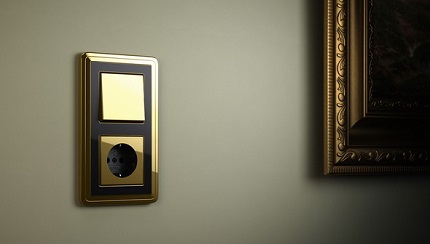
Every year, saving money and space remain priority factors.That is why, to reduce the number of wires and the used space on the wall, manufacturers of electrical appliances combined several devices in a single design.
The combination of a one- and two-key switch with a socket increases the ultimate efficiency and comfortable use of such electrical equipment.
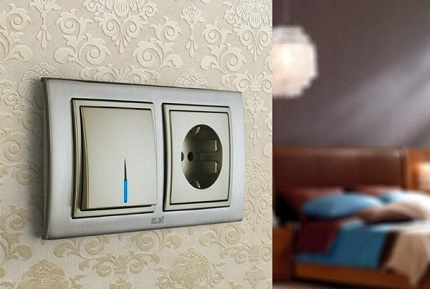
It should be remembered that to connect a block wiring device choose cable It is necessary taking into account the maximum load.
# 1: Ways to connect the switch-socket unit
There are several ways to attach a merged block. This feature has become available relatively recently. Previously, it was impossible to find electrical equipment of different options in a single building in the house.
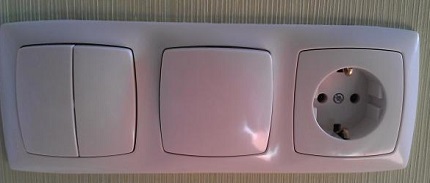
The method of connecting the switch and the socket was carried out by connecting the wiring in the box, but without mixing the devices themselves. This method is used today, if for certain reasons it is impossible to install consumers next to each other.
At the same time, the option of unpaired connection of the design also has its advantages. Consider them below:
- Similar devices are publicly available. Buying even a cheap switch with a socket will make it possible to connect them in one circuit.
- Work on connecting these electrical appliances can be done easily even with your own hands.
- Increased safety level when using separately connected mechanisms, since the wiring to them is laid separately, which reduces the likelihood of a short circuit.
So why in recent years in houses give preference to special blocks, where the combination of the outlet and the switch is laid down by the supplier. And all because a similar plan for connecting the device is more facilitated.
Firstly, there is no need to lay two separate cables to the devices. Secondly, the advantages of such a unit are much greater than those of divided ones.
We list some of them:
- Simplified transfer of such a block to another place. Now there is no need to lay two separate wiring.
- Twice to measure the height during the installation of the above devices is no longer necessary, since this is one block.
- High quality appliances can be used outdoors and indoors.
- The combined unit is easier to mount on surfaces of concrete, stone, wood and drywall.
The main disadvantage of the connected unit is that it cannot be replaced if one part is broken. It doesn’t matter if it is a network socket or directly a switch. Almost always, a complete replacement will be required.
New units are manufactured with a one-, two- or three-button switch, which is combined with a socket in the whole product.
Consider the step-by-step process of replacing a block-socket system:
After completing the dismantling of the old device and preparing the wiring, we proceed to install and connect the new unit from the outlet with a switch.
# 2: Connecting and switching the socket through the switch
There is a specific sequence that defines how to connect a socket with a switch in a one-piece design. It should be remembered that it is based on standard wiring diagrams mandatory compliance with PES.
An elementary way to connect wires from the network is to connect them to devices according to a clear plan in the distribution box.
The following work algorithm will tell you how to correctly connect a socket with a switch connected to the unit:
- For the indoor unit, a special hole in the wall is prepared, and for the outdoor unit, a suitable space for installation is selected. For rooms in wooden buildings, most often used overhead paired mechanisms with combined electrical units. This method is used, for example, with open wiring.
- The junction box has six (6) cores of incoming electrical cables. One pair for the outlet, the second from the switch, and the third for the switchboard. Each pair is a phase and zero veins. Most often in homes you can see an additional ground wire.
- First of all, we determine the phase that comes from the distribution panel, and de-energize the room.
- The next step is to connect the phase cable from the mains to the wire going to the switch. It is necessary to strip the ends of the phase conductors, then twist them together and isolate. For this, electrical tape is used.
- Next, the zero core of the network must be connected to the wire from the outlet. We also wrap them with insulating material.
- The idle edges of the wires from the combined unit are also twisted together and are necessarily rewound with electrical tape.
- This connection scheme will ensure the connection of the phase cable of the outlet through the switch. The effectiveness of this method is noticed when the network jack is very rarely used, and the connected devices must be constantly on / off.
The mechanism combined in a single body is relatively simple. Phase is supplied to the socket through the switch if the switch is activated. Such a scheme is popular, for example, if you need to heat water in a heater that does not have its own off / on button, but you do not want to pull the plug constantly.
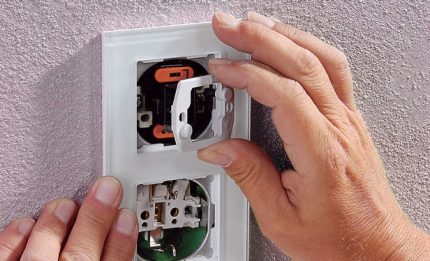
Another way is to connect the lighting in the utility room through an extension cord. Then you can turn it off just using the one-button switch.
# 3: Installation of connected sockets with a switch
Blocks of wiring devices combined in a single housing are in great demand. The main factor remains that both devices will be used separately.
To install a similar outlet and a switch from the lamp, a number of simple steps are carried out:
- From the main shield, cables with zero and phase are laid to the junction box.
- The box must contain five (5) wires - two (2) from the lamp and three (3) from the unit that combines the individual devices.
- The phase core from the shield must be connected to the wire from the outlet. Using a jumper, connect the socket to the terminal on the switch.
- A zero core from the electrical network must be connected to a wire with zero from the lamp and the outlet.
- Phase cables coming from the cartridge to the switch must be twisted and insulated.
- Grounding is also connected using the appropriate cable.
A similar circuit with an integrated socket and switch will work separately from the switch. And the main functions of a single-button circuit breaker (on / off electric lamps) will also be performed independently.
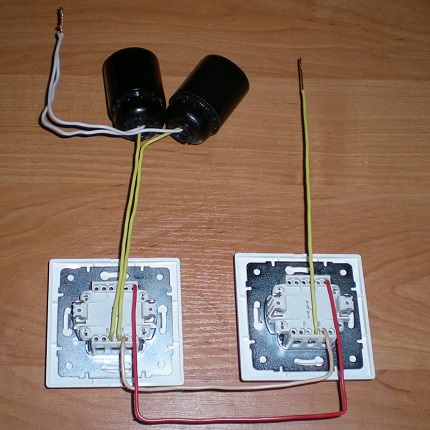
If you want to know how to connect a double switch that controls two bulbs, you should pay attention to andnext articlewhich we recommend that you familiarize yourself with.
# 4: Connecting a socket with a two-gang switch
Most often, a unit connecting a socket and a two-button switch is installed between the entrance to the toilet and the bathroom. Alternatively, it can be installed in a large room to supply voltage to one to three light sources.
Conclusion: thanks to a single unit, the user can control the light in several rooms at once, as well as connect any device that consumes electricity to the outlet.
Consider the connection diagram of a combined device consisting of 7 steps:
- The first step is to lay five (5) conductors from the distribution box to the dual electrical system.
- From the distribution panel, conductors with zero and ground are only connected to the outlet.
- Thanks to a special jumper in the linking unit, the phase is applied to the dual disconnect device.
- Both free cores are connected to the two connecting nodes of the circuit breaker, through which the phase is supplied to the lighting devices in the bathroom and the restroom.
- It is necessary to twist the cables with the phase (from the switch) with free cores (from lampholders with lamps) in the toilet and bathroom.
- In the sorting box, the cable with "0", as well as the ground wire from the outlet, must be twisted with the bare ends of the twists from the lighting.
- There are cases when the order of the keys on the switch needs to be changed. To do this, the cores on the switching contacts, supplying voltage to the lamps in the bathroom and the toilet, simply change places.
It turns out that the wiring diagram of a single and two-key switch combined with a socket differs only in the amount of time spent and the number of wires. For a one-button device, four (4) cables are used, and for two-key switch - five (5) conductors. Both options include grounding.
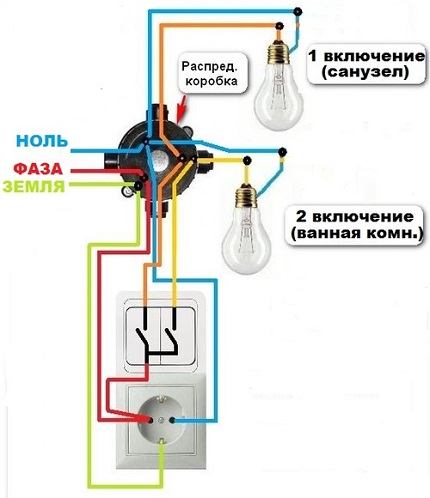
# 5: Mounting the unit with a socket and a three-gang switch
A three-gang switch with a socket is used to save energy. In recent years, is in great demand among electricians, specialists and ordinary people.
Previously, three-key switches with a socket were installed only in panel houses.Their main purpose was to control the light in the kitchen, bathroom and restroom. But the network socket was provided for domestic purposes - connecting a hairdryer, electric shaver, vacuum cleaner and other devices. Since then, a lot of time has passed, most of them need replacing.
Modern layouts and design capabilities allow the use of a three-key shutdown device as the main control link of several light sources for one room. Among them:
- main;
- additional light sources;
- decorative.
This method saves a person from the need to connect lamps with a lack of lighting. On the other hand, it protects a person from the excessive amount of light in the room and will allow you to muffle it. The light control remains under your complete control, thanks to one single switch.
In addition to convenience, such three-key block decorates the room. Agree that a single unit with a socket looks more aesthetically pleasing than three separate ones. In addition, the amount of time and effort spent installing it is much less.
A three-key device is usually mounted in rooms of this type:
- in the place where multi-tiered lighting is planned;
- in rooms with a large area and complex shape;
- in narrow and long transitional rooms;
Such a switch is also mounted to control lighting in several rooms at once, such as a toilet, bathroom and hallway, from a single place. It can also be used in workrooms to highlight a particular desktop.
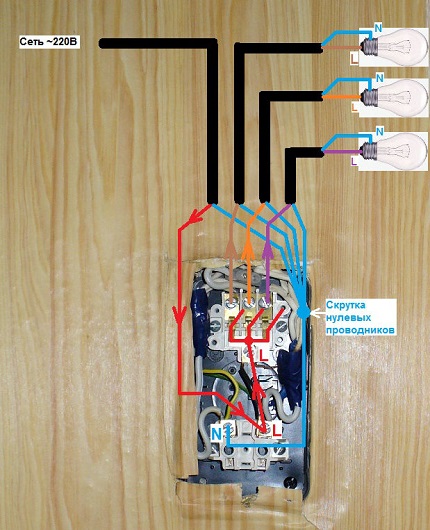
The configuration of the device with a socket is not much different from a conventional three-button switch. The zero wire going straight to the outlet is the main difference.
Previously, such a design could cause inconvenience. The passage of time has changed this rule. Since the fashion for the location of the switches has changed significantly, installing the outlet above the baseboard, and the switch at a distance of 800–900 mm from the floor, becomes an almost unclaimed option.
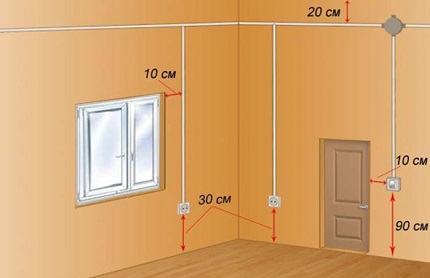
There are several rules when choosing a switch. Then it will last longer and not cause discomfort. Here are the main ones:
- keys do not sink;
- do not emit extraneous sounds when pressed;
- the internal part of the switch contains a circuit for its connection;
- smooth and even surface.
Also, attention should be paid to the degree of protection of the device - this is the IP code on the package. The first figure reflects the level of protection against dust, the second - from moisture. Value and effectiveness are indicated from zero (0 - no protection) to six (6 - highest level of protection).
For example, when installing the switch in the bathroom or in the shower room, you need to purchase a device with IP 44. If it is a street - protection level 65. When installing the switch in the relaxation room - an IP value of 20 will suffice.
When commissioning a switch with a socket, it is difficult to do without certain tools, such as:
- pliers for clamping and gripping parts;
- stripper to remove insulation from the edge of the wire;
- flat and Phillips screwdrivers.
The installation scheme of the three-key switch is also not much different from connecting a two- or one-button device.
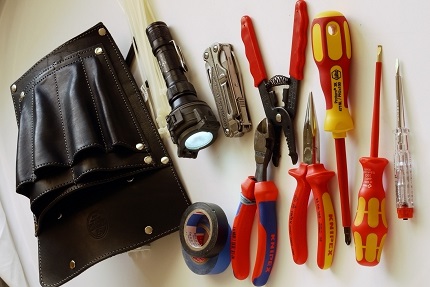
Consider them again:
- Before starting work, you need to make sure that the network is completely disconnected.
- Zero and phase cables must be distributed.
- Check the phase with a special screwdriver with indicator.
- Connect the cable to the junction box.
- Test the connection.
An important skill during installation is the skill of finding wires with zero and phase. Usually defined the wire has its own color. The zero core is blue, and the phase is black or red.
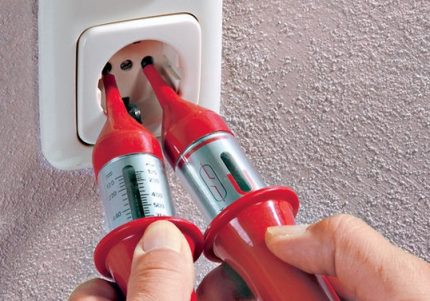
There are several ways to determine the phase. Its presence will tell the indicator on a screwdriver or a simple incandescent bulb. The first option is preferable because it is simpler. For the second method, the lamp needs to be screwed into the cartridge, and alternately shortened the output wires. When the cable is in the zero phase, the light shines brighter.

To purchase one-, two-, three-key circuit breakers with a socket - the process is not complicated. But, as practice shows, not everyone can figure out a connection plan. Therefore, this article appeared. Now it’s much easier to carry out the installation on your own, and even more so the replacement of a switch with a socket.
Finally, a few recommendations. In the process of dismantling the old block, it is better to sign each disconnected wire. This will significantly save time on connection and immediately figure out where to connect which wire.
Conclusions and useful video on the topic
Carrying out these manipulations can also be viewed in video format. In them, experienced specialists will explain and show the correct connection of all the above blocks.
Clip # 1. How to connect the socket and switch:
Clip # 2. Reliable electrician in a house or apartment: we connect correctly:
Clip # 3. Block repair with two-gang switch and socket:
Remember, if this article and video did not give you a clear idea about connecting switches, or you never encountered electrical equipment at all, especially if you have to electrical work in the bathroom, consult a professional electrician to avoid cases of electric shock or short circuit.
There is a desire to share your own experience as an electrician, have you found flaws in the article, have questions? Please write a comment located under the text block.

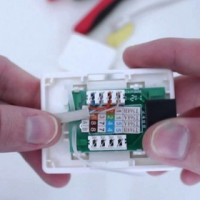 How to connect a telephone socket: connection diagram and installation rules
How to connect a telephone socket: connection diagram and installation rules 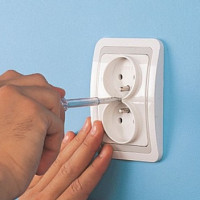 How to connect a double outlet: installing a double outlet in one socket
How to connect a double outlet: installing a double outlet in one socket 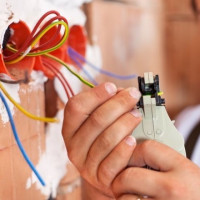 How to install and connect an outlet with grounding: learn to ground the outlet
How to install and connect an outlet with grounding: learn to ground the outlet 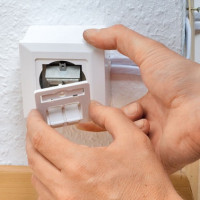 How to connect an Internet outlet: a step-by-step installation guide
How to connect an Internet outlet: a step-by-step installation guide 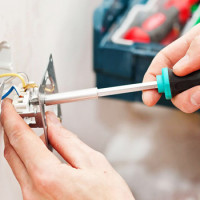 How to install and connect an outlet: a step-by-step guide
How to install and connect an outlet: a step-by-step guide 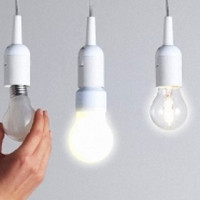 How to choose and correctly connect a three-key switch
How to choose and correctly connect a three-key switch  How much does it cost to connect gas to a private house: the price of organizing gas supply
How much does it cost to connect gas to a private house: the price of organizing gas supply  The best washing machines with dryer: model rating and customer tips
The best washing machines with dryer: model rating and customer tips  What is the color temperature of light and the nuances of choosing the temperature of the lamps to suit your needs
What is the color temperature of light and the nuances of choosing the temperature of the lamps to suit your needs  Replacement of a geyser in an apartment: replacement paperwork + basic norms and requirements
Replacement of a geyser in an apartment: replacement paperwork + basic norms and requirements
My wife and my cousin inherited a summer residence from my cousin. The house is small, seemingly quite peppy, but in fact it turned out that there are a lot of problems. The main trouble with the wiring. That is, electricity in outlets, but no. They were afraid that the cottage would burn, and even the neighboring houses would suffer. We decided to change the wiring completely. I really liked the idea with a socket-switch and it will be very useful. I will do this for sure!
I recently bought a house, I made repairs myself. When replacing the electrical wiring, I came across the question of how to combine sockets with switches in one case. I thought that this particular method will save space and save you from unnecessary wires. I realized that I could not do without outside help. I read an article about this, did everything according to the proposed schemes. Everything is working.
When we made repairs in our own house, we decided to completely replace the wiring, as it was already old.Of course, I wanted to save. We decided to put sockets and switches in one case. It is very convenient, no need to put a junction box and saving on cables. And all this is using modern European technologies again. In addition, it greatly improves the appearance and saves space.
I can’t understand anything. I decided to connect the outlet from the chandelier switch. I connect it - the chandelier stops turning on. Only one thing works - either a switch or a socket. What am I doing wrong? I don’t want to call an electrician because of such garbage.
Dmitry, combining a socket and a switch, this is a rather strange idea, which does not give any gain in anything, and creates some inconvenience. Broste head racking, do it better individually.
Good afternoon, Dmitry. The paradox is explained simply - a phase wire comes to one terminal of the switch, from the other - it goes to the chandelier. After all, the main function of the switch is phase discontinuity. The ground wire is thrown onto the chandelier from the junction box.
When powering a socket from a switch, you apply the same phase to its contacts - without a “zero” socket, it does not work. To describe electrical circuits with words is an ungrateful task. Therefore, I attached a screenshot of the circuit of your amazingly working electrical network.
It can be seen from the diagram that when the switch is open, zero reaches the outlet through the chandelier - it can supply voltage, for example, to an iron. When the switch is closed, only the phase enters the outlet - turning on the iron is useless, but the chandelier is on.